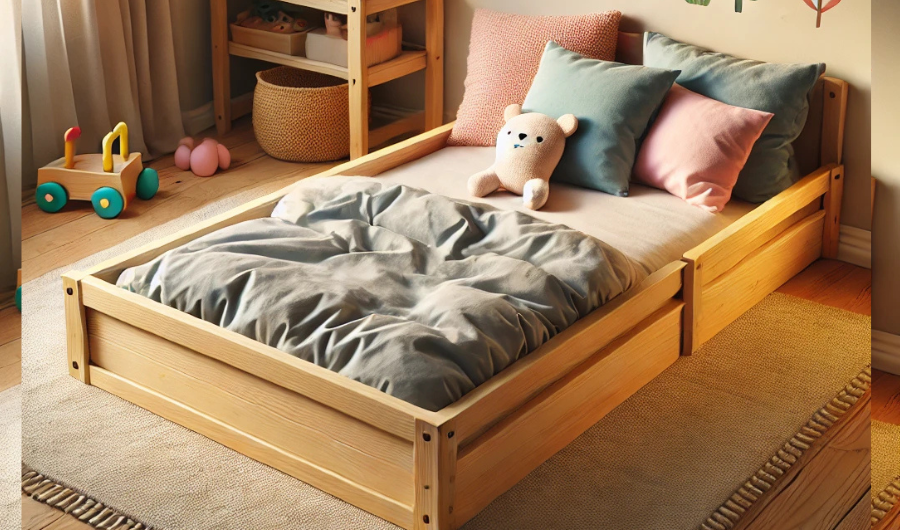Providing a secure, cozy, and developmentally appropriate sleeping space for toddlers is a primary concern for parents. The toddler floor bed is one option that parents are choosing more and more because it provides many special advantages for developing children. Toddler floor beds, which are made to offer safety, independence, and a little flair, have become well-liked due to their ease of use and beneficial effects on a child’s growth. This post will discuss the features that set toddler floor beds apart, their benefits, and how to pick the best one for your child’s requirements.
What Is a Toddler Floor Bed?
A toddler floor bed is a mattress on the floor or low to the ground, frequently with a simple frame around it. Toddlers can get in and out of these beds independently because they usually don’t have high sides or railings. The Montessori approach, which prioritizes encouraging children’s independence and self-sufficiency from an early age, served as the model for floor beds.
Unlike traditional cribs and toddler beds, which require a child to be lifted in and out, floor beds allow children to move freely, instilling a sense of autonomy and control.
Benefits of a Toddler Floor Bed
1. Encourages Independence
Floor beds help children develop independence by allowing them to enter and exit their beds on their own. This freedom of movement is consistent with Montessori principles, giving toddlers greater control over their sleeping environment and reducing reliance on adults for bedtime routines.
2. Promotes Safe Exploration
Being low to the ground, floor beds offer a safe space for toddlers to explore their surroundings. If they wake up in the middle of the night or early in the morning, they can move around without fear of falling from a height, as they would in a traditional bed or crib.
3. Eases Transition from Crib to Bed
For young children, moving from a crib to a regular bed can be intimidating. With the help of floor beds, children can transition from the confines of crib rails to sleeping in an open bed. They facilitate the transition and are less frightening than a taller bed.
4. Supports Developmental Needs
Children can use floor beds to independently navigate their space, which can help them reach a variety of developmental milestones, including gross motor skills. Learning to control their own sleep and wake cycles can also help them become more self-assured.
5. Improves Parent-Child Bonding
The ability to sit or lie down next to their child is made easier by floor beds, which is especially useful for bedtime stories, cuddling, and soothing a child after a nightmare. The intimate physical contact improves the quality of time spent together and contributes to a calm nighttime atmosphere.
Choosing the Right Toddler Floor Bed
Several factors should be taken into account when choosing a floor bed to make sure it fits your child’s needs, safety regulations, and comfort level. Here are some important things to remember:
1. Size and Mattress Height
The sizes of toddler floor beds range from crib-size to twin-size mattresses. The length of time you intend to use the bed and the age of your child will determine whether a larger size is better suited for prolonged use. Make sure your toddler can easily access the mattress by choosing one that is low to the floor.
2. Material and Frame Quality
The frame material ought to be hypoallergenic, non-toxic, and robust. Since natural wood and eco-friendly materials are frequently safer and more resilient, look for frames made of these materials. While some parents choose frames that are directly on the floor, others choose frames that are slightly raised and have ventilation slats built in.
3. Safety Features
In general, floor beds are safer for toddlers to use on their own because they are lower to the floor. But keep in mind things like smooth finishes, rounded frame edges, and making sure the bed is free of any small or sharp parts that could be dangerous.
4. Design and Aesthetic Appeal
Many floor beds come in unique shapes, such as house frames, teepees, and classic minimalist designs. Choose a design that complements the room’s decor and reflects your toddler’s personality, making bedtime a fun experience. The design should also allow for good airflow and comfort.
How to Create a Safe and Comfortable Environment Around a Floor Bed
Setting up a floor bed entails more than just the bed. The surrounding environment is critical in creating a safe and comfortable sleep environment. Here are some tips for making your child’s floor bed safe and comfortable:
1. Childproof the Room
Your child can freely explore the room when they have a floor bed. Keep breakable or sharp objects out of reach, cover electrical outlets, secure heavy furniture to the wall, and eliminate choking hazards to create a safe environment.
2. Use Soft Flooring
Consider placing a plush rug or carpet close to the bed to create a secure and cozy space. This makes a comfortable space for play and provides an additional layer of cushioning in case your child rolls out of bed while they are sleeping.
3. Control Lighting and Noise Levels
Use blackout curtains to make your room darker and more sleep-friendly because a bright room can keep your child awake. If the dark frightens your toddler, think about getting a nightlight or a soft, dimmable lamp. Furthermore, a white noise generator can be used to reduce distracting noises and establish a relaxing environment.
4. Incorporate Bedtime Routines
Because a floor bed gives your child more autonomy, it is critical to establish a structured bedtime routine. To help them feel at ease in their bed, engage in calming activities such as reading a book, singing a lullaby, or speaking softly. This can help them establish a strong sleep association with their floor bed.
Toddler Floor Bed FAQs
1. Is a floor bed safe for my toddler?
Yes, floor beds are generally safe for toddlers, especially if the room is childproofed. The low height of the bed minimizes the risk of injury, even if they roll off the mattress.
2. What age is appropriate for a floor bed?
Floor beds are suitable for children around 18 months and older. However, it’s important to consider each child’s individual readiness, particularly if they are transitioning from a crib.
3. Do floor beds make sleep training harder?
Some parents find that floor beds help with sleep training by encouraging independence, while others prefer to start with a crib. Every child is different, so experiment with what works best for your family.
4. How can I help my toddler stay in bed?
Establishing a consistent bedtime routine, using calming activities, and making the floor bed an inviting, safe space can encourage your toddler to stay in bed throughout the night.
Tips for Transitioning Your Toddler to a Floor Bed
Switching from a crib to a floor bed can be an exciting experience for toddlers, but a gradual transition can help alleviate any anxiety. Here are some steps to make the process easier:
- Start Slowly: Allow your toddler to nap in a floor bed during the day to familiarize him or her with the concept. This will help them become acquainted with the surroundings.
- Create a Routine: Consistent bedtime routines help children understand what to expect and feel more at ease in their new sleep environment.
- Add Personal Touches: To create a cosy atmosphere, surround the floor bed with your toddler’s favourite blankets, books, or toys.
- Be Patient: It is normal for children to take some time to adjust to a new sleep environment. Encourage them to stay in bed, but remember that it may take a few nights for them to fully adjust.
Final Words
Toddler floor beds are a useful solution with a foundation in child-centred design, not just a passing fad. Floor beds complement the objectives many parents have for their child’s development and well-being by encouraging independence, offering a secure setting, and meeting developmental needs. A toddler floor bed can provide a nurturing, empowering alternative for your developing child, regardless of your preference for a seamless transition from the crib or a sleep schedule influenced by Montessori.

